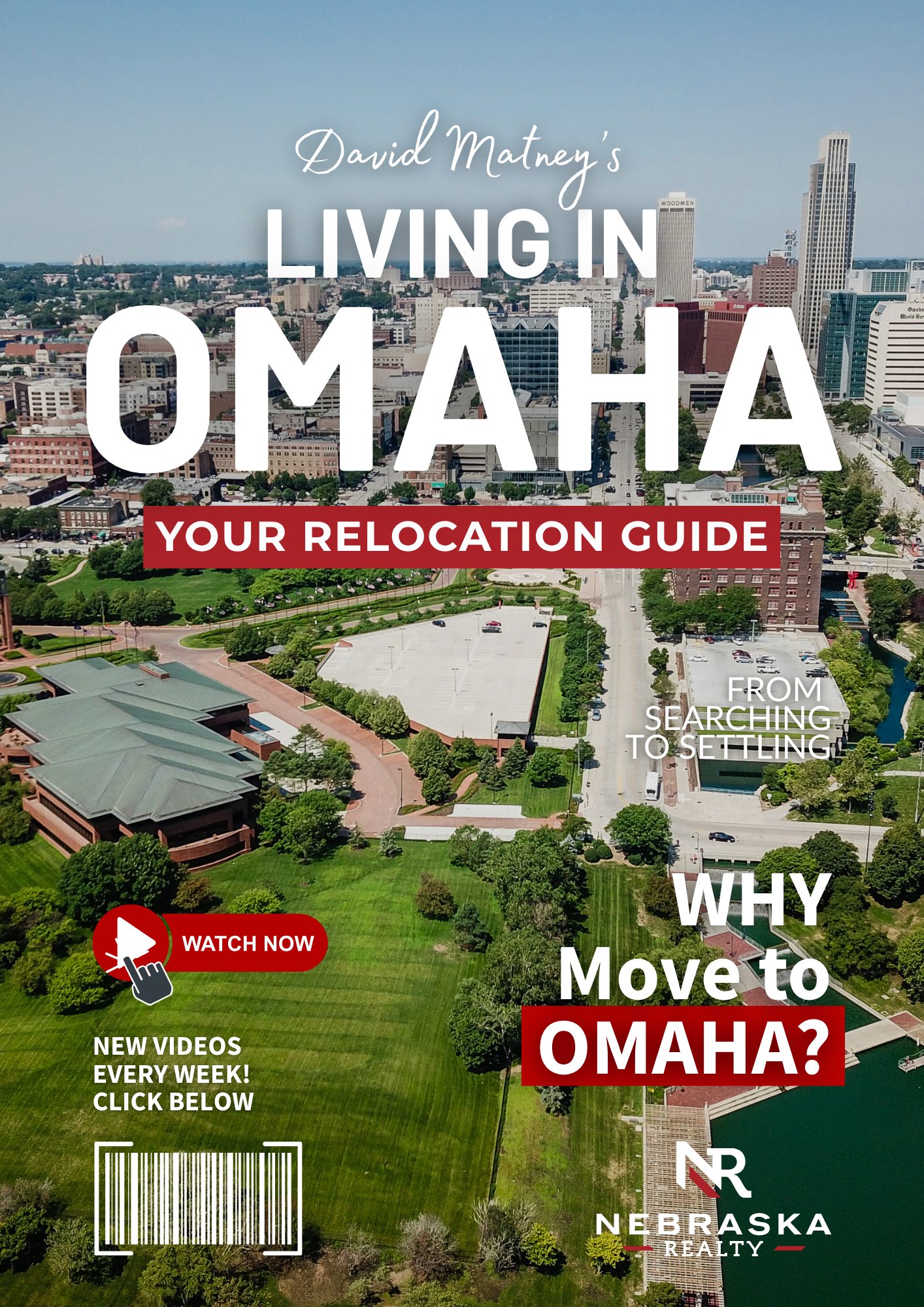The Pros and Cons of Living in Omaha, Nebraska! (What You Need to Know Right Now!)
Hi — I’m David Matney from Living in Omaha, and in this guide I’ll walk you through the pros and cons of Living in Omaha, Nebraska so you can make an informed decision about whether this city belongs on your relocation shortlist. I created a video covering the same ground, and here I’m expanding on that conversation: the good, the bad, and the ugly — from unpredictable weather and property taxes to terrific schools, strong jobs, and a high overall quality of life.
The pros and cons of Living in Omaha, Nebraska are worth weighing carefully. As someone who helps people relocate here for a living, I’ve seen families come and go and come back again. The people are friendly, the economy is solid, and the city feels like a big town in the best possible way. But the pros and cons of Living in Omaha, Nebraska include weather that changes on a dime and property taxes that bite. Read on — I’ll lay everything out and add practical tips so you’re not surprised after you move.
Table of Contents
- Introduction to Pros and Cons of Living in Omaha, Nebraska
- The Weather in Omaha, Nebraska
- Taxes in Omaha, Nebraska
- Public Transportation in Omaha, Nebraska
- Environmental Concerns in Omaha, Nebraska
- Omaha, Nebraska is an Isolated City
- The People in Omaha, Nebraska
- Jobs and the Economy in Omaha, Nebraska
- Education in Omaha, Nebraska
- Overall Quality of Life and Things to Do in Omaha, Nebraska
- Conclusion: Weighing the Pros and Cons of Living in Omaha, Nebraska
- FAQs About Pros and Cons of Living in Omaha, Nebraska
- Final Thoughts and Next Steps
Introduction to Pros and Cons of Living in Omaha, Nebraska
When people ask me about the pros and cons of Living in Omaha, Nebraska the first things I talk about are quality of life, cost of living, and safety. Omaha combines a Midwest friendliness with an unexpectedly diverse set of cultural and recreation options. The city supports major employers, has top-tier healthcare, and offers family-friendly neighborhoods that attract parents and young professionals alike.
The pros and cons of Living in Omaha, Nebraska aren’t just theoretical — they’re practical realities that affect moving costs, daily commutes, school choices, and even weekend plans. Below I break everything into digestible sections using the same chapter structure I used when explaining this on video: Taxes; Public Transportation; Environmental Concerns; Isolated; The People; Jobs; Education; and Overall Quality of Life. Wherever it helps I’ll include numbers, timelines, and actionable advice.
The Weather in Omaha, Nebraska
Let’s start with weather because it’s one of the top-cons people mention when I talk about the pros and cons of Living in Omaha, Nebraska. Omaha’s weather is famously unpredictable — there’s a local saying: if you don’t like the weather, wait 24 hours. We really do experience all four seasons, and sometimes all four in a single week.
The pros and cons of Living in Omaha, Nebraska include weather extremes: cold, snowy winters and hot, humid summers. Spring and early summer bring thunderstorms that can produce strong winds, flash flooding, hail, and even tornadoes. In April 2024 we experienced an EF4 tornado that impacted communities northwest of town. Severe weather is real here, and preparedness matters.
Most homes in Omaha have basements, which is handy when tornado watches or warnings are issued. A watch means conditions are favorable; a warning means immediate shelter. Don’t be fooled when longtime locals seem unconcerned — they know the rhythms of our storms, but you should always take alerts seriously. Monthly siren tests happen on the first Wednesday at 11:00 a.m., weather permitting, so don’t panic when you hear them then.

The pros and cons of Living in Omaha, Nebraska include higher homeowner insurance for homeowners in storm-prone areas. Hail is a frequent culprit of damage; it’s hit-or-miss and can cause roof damage in one block and leave a nearby street untouched. If you suspect hail damage after a storm, call a trusted local roofer to inspect before filing an insurance claim — most roofers will advise you whether a claim is warranted.
Flash flooding around the Papillion Creek has led to the creation of damsite lakes intended to manage storm water; these lakes are great for recreation and have trails but are reminders that significant rain events do occur. Floodplain homes require flood insurance, and that coverage can be costly — another factor to include when comparing the pros and cons of Living in Omaha, Nebraska.
Winters can be long, cold, and gray. When December afternoons roll around, darkness comes early — at 5:00 p.m. it can already be night. Freeze-thaw cycles damage roads, creating the spring pothole season that locals joke about. Many people say Omaha actually has two seasons: winter and road construction. And even on nice days, Omaha can be very windy because there’s no mountain range or other natural barrier to block gusts.
Taxes in Omaha, Nebraska
Tax considerations are high on the list when people ask me about the pros and cons of Living in Omaha, Nebraska. Nebraska may lean politically conservative, but the tax burden — especially property tax — can feel more like a blue-state reality. Home prices are reasonable compared to many coastal markets, but property taxes are higher than many people expect.
Let me illustrate: a house I sold on Mason Street for $586,000 had 2023 property taxes of about $7,800. In Douglas and Sarpy counties, property taxes are paid in arrears — that means 2023 taxes are paid in 2024. If you’re budgeting for a monthly mortgage, always add property taxes and homeowner’s insurance to your calculations. Those two items can materially change the monthly payment compared to sticker price alone.
The pros and cons of Living in Omaha, Nebraska include some reliefs: there are homestead exemptions available for qualifying seniors, veterans with 100% service-connected disability, and disabled individuals. If you think you qualify, apply — it can help. But most buyers won’t qualify for those exemptions, so plan as if you’ll pay full property tax until you learn otherwise.

Beyond property taxes, Nebraska has a state sales tax of 5.5%. Cities often add their own tax — Omaha adds 1.12% city tax bringing the sales tax in Omaha to 7%. There’s also a prepared food or restaurant tax (2.5%), which means dining out includes state sales tax, city sales tax, and the restaurant tax. Groceries and prescription drugs are not taxed, which helps families. For anyone considering the pros and cons of Living in Omaha, Nebraska, these consumption taxes are worth noting if you dine out frequently.
License and vehicle fees in Nebraska are another cost many newcomers overlook. We have a motor vehicle tax based on the age of your car, and additional vehicle fees based on value, weight, and use. When you buy a car and take it to the DMV, you’ll pay sales tax on that purchase at registration. That adds a chunk to your moving costs if you plan to buy a vehicle soon after relocating.
On a positive note, Nebraska recently made changes to Social Security taxation. In 2024 Governor Pillen signed a bill granting a full tax exemption for Social Security benefits. That’s welcome news for retirees and factors into the pros and cons of Living in Omaha, Nebraska for those planning retirement here.
Nebraska’s state income tax is graduated. As of January 2024, brackets ranged from roughly 2.46% to 5.84%. Importantly, the top bracket is scheduled to drop over the next few years — 5.2% in 2025, 4.55% in 2026, and 3.99% in 2027. Those reductions are part of broader tax reform efforts and improve the outlook when weighing the pros and cons of Living in Omaha, Nebraska.
Practical tip: When you’re comparing cities, don’t ignore property taxes and insurance. Ask for an estimate of annual property tax on any home you’re considering and get an insurance quote before signing. For many buyers, taxes and insurance will be the difference between a comfortable monthly payment and a strained budget.
Public Transportation in Omaha, Nebraska
Another important entry in the pros and cons of Living in Omaha, Nebraska is public transportation. Omaha is still a car-centric city. You’ll need a vehicle for most errands and most commutes, unless you live in or near downtown or along major bus routes.
We have a Metro Bus system and an “Orbit” rapid bus system that runs along Dodge Street. A 30-day unlimited bus pass costs about $55, which is a reasonable deal if you plan to rely on transit. Students at Creighton University and the University of Nebraska at Omaha can ride Metro buses and Orbit for free using their campus ID cards — a great perk.

Orbit buses are articulated and equipped with bike racks, so you can mix biking and transit easily. The bus network provides decent coverage downtown and in surrounding North and South Omaha neighborhoods, but service thins out the farther you get from the core. That’s one of the cons of Living in Omaha, Nebraska: limited service in many suburban corridors.
A major development to watch: the Omaha streetcar project. Not everyone is a fan, but the streetcar is planned to operate from the riverfront to Nebraska Medicine along Farnam Street. Construction is slated to begin in 2025, with service targeted for late 2027 or early 2028. The fare structure includes free rides for those who live downtown or work at certain large employers like Mutual of Omaha and Nebraska Medicine — a potential game-changer for downtown residents and workers.
The pros and cons of Living in Omaha, Nebraska here depend on where you plan to live: downtowners and those working along the streetcar/Orbit corridors will find transit increasingly viable. If you’re moving to a suburban neighborhood without bus service, plan on driving.
Environmental Concerns in Omaha, Nebraska
Now for a heavier topic: environmental concerns are an important part of the pros and cons of Living in Omaha, Nebraska. Two issues stand out locally — lead contamination (in older homes and in historic industrial soil) and radon gas.
Lead-based paint was commonly used in homes built before 1978. There’s no safe level of lead in blood, and lead poses the greatest risk to children under six. If you’re buying an older house, expect to sign a lead-based paint disclosure. If selling a home where buyers are using FHA financing, chipped or peeling paint will often be required to be remediated before closing.
Another legacy problem comes from historic industry: the old lead smelting plant that operated along the riverfront contaminated soil across a wide swath of eastern Omaha. In the late 1990s the EPA designated the area as one of the largest lead Superfund sites in the country. Over the past decades the EPA has worked to test and, where necessary, replace contaminated soil. If you purchase a home in affected neighborhoods, you may be asked to sign a lead site disclosure. You can check remediation records and test results at local resources (for example, city or EPA websites) to see what remediation has been done at a specific property.

Radon is the other major environmental health concern. Radon is a naturally occurring, invisible, odorless radioactive gas that is the leading cause of lung cancer among non-smokers. More than half of homes tested in Nebraska have measured radon above the EPA action level of 4.0 picocuries per liter (pCi/L). Radon testing is inexpensive and straightforward — a two- to three-day test typically costs around $200, and when buying a home you usually have a 14-day inspection window to run tests.
If a radon test average exceeds 4.0 pCi/L, you can ask the seller to install a radon mitigation system. Mitigation generally involves a 6-inch PVC pipe sealed under the slab and a fan to create negative pressure and vent radon safely outside. Budget roughly $2,000 for a mitigation system, though prices vary. For new construction: any home built after September 1, 2019 must include a passive radon mitigation system (a pipe stub without a fan), making it easier to install an active system later if needed.
Practical advice: whenever you’re evaluating properties, ask whether radon testing has been done and what the results were. If testing wasn’t done, make it a priority in your inspection window. A $200 test and a potential $2,000 mitigation are small prices compared to the cost of long-term health consequences.
Omaha, Nebraska is an Isolated City
Omaha is isolated geographically in a way that some people like and others don’t — another important pro and con to consider among the pros and cons of Living in Omaha, Nebraska. Omaha is the largest city in Nebraska, but the metro population is still under one million. The next-largest Nebraska city, Lincoln, is about 45 minutes away. Major metro areas like Kansas City, Minneapolis, Denver, and Chicago are all many hours away by car.
For come-and-go travelers, Eppley Airfield used to be one of the complaints about life in Omaha — limited nonstop options. But Eppley is undergoing a nearly $1 billion expansion that will add gates capable of international flights and significantly improve options for long-distance travel. That expansion is another factor changing the pros and cons of Living in Omaha, Nebraska in a positive way.
If you want instant access to a major international airport or frequent weekend hops to coastal cities, you’ll find Omaha more isolated than larger hubs. But if you value shorter commutes, lower congestion, and a quieter lifestyle, that isolation is actually a pro. It boils down to lifestyle preference.
The People in Omaha, Nebraska
One of the biggest pros of Living in Omaha, Nebraska is the people. I might be biased, but Midwesterners tend to be hardworking, honest, and community-oriented. That work ethic and the region’s reputation for civility attract employers and newcomers alike. People move to Omaha for schools, healthcare, and a strong sense of community.

Omaha often feels like a “big small town.” People complain about weather and taxes everywhere — but once you live here you’ll likely notice how approachable folks are and how organizations step up to solve problems. Omaha is a philanthropic community that tackles homelessness and other social challenges head-on with nonprofit efforts and civic initiatives.
Does that mean there’s no crime? No. We have crime like any midsize city. But relative to large metropolitan areas, many residents find Omaha to feel safer and more family-friendly. If you’re weighing the pros and cons of Living in Omaha, Nebraska for family reasons, the social temperament and community support structure often rank high on the pro side.
Jobs and the Economy in Omaha, Nebraska
Let’s talk about jobs — a major pro for many people considering Omaha. The pros and cons of Living in Omaha, Nebraska tilt positive when you look at employment. Omaha is home to four Fortune 500 companies: Mutual of Omaha, Kiewit Corporation, Union Pacific, and Berkshire Hathaway. Those corporate headquarters provide high-quality, stable employment opportunities.
Offutt Air Force Base in Bellevue is another major employer and adds economic diversity. Offutt hosts the 55th Wing and is the headquarters for U.S. Strategic Command — that means a steady stream of defense and government jobs in the region. Other strong sectors include education, healthcare, manufacturing, transportation, construction, and a growing tech presence.

Recent investments such as massive data centers by Google and Meta (Facebook) in Douglas and Sarpy Counties have strengthened the local economy and brought construction and long-term infrastructure investment. The unemployment rate in the Omaha area tends to be below the national average thanks to this diversity and stability. A common saying here is: we aren’t always invited to the party, so we don’t suffer the hangover — meaning Omaha tends to avoid boom-and-bust extremes.
When weighing the pros and cons of Living in Omaha, Nebraska, remember that a stable economy makes home values less volatile in downturns. During the Great Financial Crisis Omaha saw modest dips and longer sales times, but not the dramatic collapses experienced in some other markets.
Education in Omaha, Nebraska
For families, education is often the decisive factor. One of the major pros of Living in Omaha, Nebraska is access to a strong public education system and quality postsecondary options. That’s why the real estate market here is very school-district-driven — people choose neighborhoods based on school boundaries.
Not all schools are equal, and different families prioritize different programs — arts, sports, STEM, or college-prep curricula. If schools are critical to your move, do the homework. Use the Nebraska Education Profile to check graduation rates, test scores, and other metrics as a starting point. Local school district boundaries can change with growth, especially in Southwest Omaha where new schools are being built to keep up with development.

Omaha also offers higher education options including the University of Nebraska at Omaha (UNO) and Creighton University, plus a community-college network (Metro Community College) with multiple campuses. For healthcare and medical training, Nebraska Medicine is our region’s Level I trauma center and a top-ranked hospital. That access to top-tier care and training makes Omaha a strong choice for families focused on education and health.
Overall Quality of Life and Things to Do in Omaha, Nebraska
When people ask me to sum up the pros and cons of Living in Omaha, Nebraska, quality of life almost always features as a top pro. Forbes named Omaha one of the best cities to move to in recent years, and it’s easy to see why: family-friendly attractions, affordable housing relative to many metros, strong healthcare, and a vibrant cultural scene.
Omaha packs an impressive list of attractions into a mid-sized city. The Henry Doorly Zoo and Aquarium is world-class. The Gene Leahy Mall and Riverfront redevelopment with Lewis and Clark Landing are beautiful public spaces. The Durham Museum in historic Union Station, the Joslyn Art Museum, the Orpheum Theater, and the Rose Theater offer arts and history opportunities. The new Luminarium (Omaha’s STEM museum) and Bob Kerrey Pedestrian Bridge provide family-friendly outings close to downtown.

Outdoor options include Fontenelle Forest, the Strategic Air and Space Museum, wildlife safari parks, and walking and bike trails around the Papillion Creek and damsite lakes. Historic homes like Joslyn Castle and the General Dodge House, along with neighborhoods like Aksarben, Dundee, Benson, Blackstone, and Florence, each bring unique character and amenities to the metro.
The pros and cons of Living in Omaha, Nebraska balance out: you get a high quality of life with cultural institutions, parks, and dining, but you also trade some of the hustle-and-bustle and broader transit options that big coastal cities offer. For many families and professionals, that trade-off is exactly what they want — a quieter, safer environment with access to good jobs and community life.
Conclusion: Weighing the Pros and Cons of Living in Omaha, Nebraska
So what does all this mean for you? The pros and cons of Living in Omaha, Nebraska are real and measurable. On the pro side: friendly people, a stable and diversified job market, strong schools and healthcare, affordable housing relative to many metros, and a high overall quality of life with many cultural and outdoor activities. On the con side: unpredictable and sometimes severe weather, higher property taxes and certain municipal taxes, limited public transit outside core areas, and specific environmental concerns to be aware of when buying older homes or properties near former industrial sites.
If you’re thinking about moving here, here’s a practical checklist that addresses the pros and cons of Living in Omaha, Nebraska and helps you prepare:
- Budget for property taxes and homeowner insurance in your monthly mortgage calculation.
- Obtain a roof inspection after major storms — hail damage can be localized.
- Include a radon test in your home inspection contingency and be prepared to negotiate mitigation if results exceed 4.0 pCi/L.
- Check for lead-based paint disclosures for any home built before 1978 and EPA site cleanup records for properties in eastern Omaha.
- Consider commute and transit options: if you rely on public transit, prioritize neighborhoods near Orbit lines or planned streetcar routes.
- Verify school boundaries and performance metrics if schools are a priority for your move.
- Explore neighborhoods in person — Omaha neighborhoods vary widely in character, amenities, and price.
Ultimately, deciding whether the pros and cons of Living in Omaha, Nebraska balance in your favor is a personal decision. If you prioritize community, stability, and family-friendly amenities, Omaha is a top contender. If nonstop travel, mild year-round weather, or very low property tax are deal-breakers for you, another city may fit better.
If you want to talk specifics — neighborhoods, schools, tax estimates, or the current housing market — I offer free relocation strategy calls and I’d be happy to help you run the numbers and tour properties that match your priorities.
FAQs About Pros and Cons of Living in Omaha, Nebraska
Are property taxes in Omaha really that high?
Property taxes in the Omaha metro are higher than in some states, and they can be a shock if you’re relocating from an area with lower taxes. When evaluating homes, always ask for the annual property tax amount and confirm when taxes are paid (Douglas and Sarpy counties pay in arrears). Also factor in homeowner’s insurance — a high insurance rate is common due to storm risk. The pros and cons of Living in Omaha, Nebraska require active budgeting for these costs.
How bad is the weather in Omaha?
The weather can swing widely: icy winters, humid summers, and severe thunderstorms in spring and early summer. Tornadoes and hail happen but are localized. The practical response is preparedness: know your storm shelter, inspect your roof after major hail events, and plan for winter driving. Weather is a central entry in the pros and cons of Living in Omaha, Nebraska, and it’s manageable with preparation.
Do I need a car in Omaha?
For most people, yes. Outside downtown and the main bus corridors, public transit is limited. Metro bus and Orbit are improving service, and the upcoming streetcar will add options for downtown residents and workers on its route. If you live or work near those corridors, you may be able to reduce reliance on a car. Transportation is an essential factor in assessing the pros and cons of Living in Omaha, Nebraska.
How common is radon in Omaha homes?
Radon is common in Nebraska — over half of homes tested in the state register radon above the EPA action level (4.0 pCi/L). A short-term test costs about $200 and should be included in your inspection contingency. If readings exceed the action level, mitigation is affordable relative to the health risks — budget around $2,000 for a system in most homes. Radon awareness is a major component of the pros and cons of Living in Omaha, Nebraska.
What Omaha neighborhoods are best for families?
Neighborhood choice depends on school priorities, commute, and lifestyle. Popular family-friendly areas include Dundee (tree-lined streets, older homes), Aksarben/Elmwood (near UNO, mixed-use), Benson (arts and nightlife), Blackstone (restaurants and walkability), and suburbs like Papillion and Elkhorn for newer subdivisions and schools. When evaluating the pros and cons of Living in Omaha, Nebraska, match neighborhoods to your school and commute needs.
How is the job market in Omaha?
The job market is a pro. Omaha boasts several Fortune 500 companies, a large military presence at Offutt, and growing tech infrastructure like data centers. Healthcare and education are strong employers too. Unemployment tends to be below the national average, giving the city a stable economic footing — a major plus among the pros and cons of Living in Omaha, Nebraska.
Are there environmental hazards I should worry about in Omaha?
Historic lead contamination and radon are the main issues. Lead paint in pre-1978 homes and historic soil contamination in parts of eastern Omaha are real concerns, but both have known testing and remediation strategies. If you’re considering historic neighborhoods or riverfront properties, check EPA records and ask sellers for remediation documentation. These environmental factors are critical when weighing the pros and cons of Living in Omaha, Nebraska.
Is Omaha a good place to retire?
Many retirees choose Omaha because of healthcare access, affordability compared to many metros, and a friendly community. The 2024 Social Security tax exemption improves the financial outlook for retirees. Consider property taxes and your preferred climate when deciding — the pros and cons of Living in Omaha, Nebraska vary with individual priorities in retirement.
Final Thoughts and Next Steps
The pros and cons of Living in Omaha, Nebraska are nuanced. If you value strong schools, good healthcare, a stable job market, and a community-focused lifestyle, Omaha is very attractive. If you prefer year-round mild weather, a sprawling transit network, or rock-bottom property taxes, you may want to compare Omaha closely to other options.
If you want to dive deeper, I’d be glad to help you with a relocation strategy call where we can run numbers, discuss neighborhoods, and map school options based on your family’s needs. I’ve helped hundreds of people move to Omaha and I’ll be candid with you about which neighborhoods match your priorities and how to avoid common pitfalls.
Thanks for reading this in-depth look at the pros and cons of Living in Omaha, Nebraska. If you’re curious about house prices in specific neighborhoods, want a referral for radon testing or roof inspection, or want to understand property taxes for a particular address, reach out — I’m happy to help. Omaha is a city with real strengths and a few real trade-offs, and the more informed you are the better your move will go.
DAVID MATNEY
David Matney is a trusted Realtor® and local expert with over 20 years of experience in Omaha’s real estate market.













